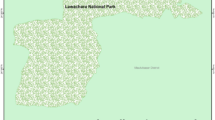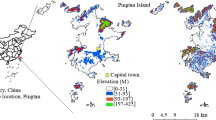Abstract
Rapid urbanization and urban greening have caused great changes to urban forests in China. Understanding spatiotemporal patterns of urban forest leaf area index (LAI) under rapid urbanization and urban greening is important for urban forest planning and management. We evaluated the potential for estimating urban forest LAI spatiotemporally by using Landsat TM imagery. We collected three scenes of Landsat TM (thematic mapper) images acquired in 1997, 2004 and 2010 and conducted a field survey to collect urban forest LAI. Finally, spatiotemporal maps of the urban forest LAI were created using a NDVI-based urban forest LAI predictive model. Our results show that normalized differential vegetation index (NDVI) could be used as a predictor for urban forest LAI similar to natural forests. Both rapid urbanization and urban greening contribute to the changing process of urban forest LAI. The urban forest has changed considerably from 1997 to 2010. Urban vegetated pixels decreased gradually from 1997 to 2010 due to intensive urbanization. Leaf area for the study area was 216.4, 145.2 and 173.7 km2 in the years 1997, 2004 and 2010, respectively. Urban forest LAI decreased sharply from 1997 to 2004 and increased slightly from 2004 to 2010 because of numerous greening policies. The urban forest LAI class distributions were skewed toward low values in 1997 and 2004. Moreover, the LAI presented a decreasing trend from suburban to downtown areas. We demonstrate the usefulness of TM remote-sensing in understanding spatiotemporal changing patterns of urban forest LAI under rapid urbanization and urban greening.








Similar content being viewed by others
References
Baret F, Guyot G (1991) Potentials and limits of vegetation indexes for LAI and APAR assessment. Remote Sens Environ 35:161–173
Baycan-Levant T, Vreeker R, Nijkamp P (2009) A multi-criteria evaluation of green spaces in European cities. Eur Urban Reg Stud 16(2):193–213
Bowler DE, Buyung-Ali L, Knight TM, Pullin AS (2010) Urban greening to cool towns and cities: a systematic review of the empirical evidence. Landsc Urban Plan 97:147–155
Cao SX, Chen L, Liu ZD (2009) An investigation of Chinese attitudes towards the environment: case study using the Grain for Green Project. AMBIO 38:55–64
Chander G, Markham B (2003) Revised Landsat-5 TM radiometric calibration procedures and post calibration dynamic Ranges. IEEE Trans Geosci Remote Sens 41:2674–2677
Clark DA, Brown S, Kicklighter DW, Chambers JQ, Thomlinson JR (2001) Measuring net primary production in forests: concepts and field methods. Ecol Appl 11(2):356–370
Convertino M, Muñoz-Carpena ML, Chu-Agor GA, Kiker I (2014) Untangling drivers of species distributions: global sensitivity and uncertainty analyses of MAXENT. Environ Model Softw 51:296–309
Dallimer M, Tang Z, Bibby PR, Brindley P, Gaston KJ, Davies ZG (2011) Temporal changes in greenspace in a highly urbanized region. Biol Lett 7:763–766
Du PJ, Li XL, Cao W, Luo Y, Zhang H (2010) Monitoring urban land cover and vegetation change by multi-temporal remote sensing information. Min Sci Technol 20(6):922–932
Dwivedi P, Rathore SC, Dubey Y (2009) Ecological benefits of urban forestry: the case of Kerwa Forest Area (KFA), Bhopal, India. Appl Geogr 29:194–200
Fowler D, Skiba U, Nemitz E, Choubedar F, Branford D (2004) Measuring aerosol and heavy metal deposition on urban woodland and grass using inventories of 210 Pb and metal concentrations in soil. Water Air Soil Poll 4:483–499
Franklin SE, Giles PT (1995) Radiometric processing of aerial and satellite remote sensing imagery. Comput Geosci 21:413–425
Franklin J, Hiernaux P (1991) Estimating foliage and woody biomass in Sahelian and Sudanian woodlands using a remote sensing model. Int J Remote Sens 12(6):1387–1404
Freitas SR, Mello M, Cruz C (2005) Relationships between forest structure and vegetation indices in Atlantic Rainforest. For Ecol Manag 218:353–362
Frolking S, Palace M, Clark DB, Chambers JQ, Shugart HH, Hurtt GC (2009) Forest disturbance and recovery-A general review in the context of space-borne remote sensing of impacts on aboveground biomass and canopy structure. J Geophys Res 114:1–27
Gong P, Pu RL, Biging GS (2003) Estimation of forest leaf area index using vegetation indices derived from Hyperion hyperspectral data. IEEE T Geosci Remote 41(6):1355–1362
Gower ST, Kucharik CJ, Norman JM (1999) Direct and indirect estimation of leaf area index, fAPAR, and net primary production of terrestrial ecosystems. Remote Sens Environ 70:29–51
Gray J, Song CH (2012) Mapping leaf area index using spatial, spectral, and temporal information from multiple sensors. Remote Sens Environ 119:173–183
Hardisky MA, Klemas V, Smart RM (1983) The influence of soil salinity, growth form, and leaf moisture on the spectral radiance of Spartina alterniflora canopies. Photogramm Eng Remote Sens 49:77–83
Huang X, Huang XJ, Chen C (2009) The characteristic, mechanism and regulation of urban spatial expansion of Changchun. Areal Res Dev 5:68–72
Imhoff ML, Ping Z, Wolfe RE, Bounoua L (2010) Remote sensing of the urban heat island effect across biomes in the continental USA. Remote Sens Environ 114:504–513
Ingram JC, Terence P, Dawson J (2005) Mapping tropical forest structure in southeastern Madagascar using remote sensing and artificial neural networks. Remote Sens Environ 94:491–507
Ji L, Wylie BK, Nossov DR, Peterson B, Waldrop MP, McFarland JW, Rover J (2012) Estimating aboveground biomass in interior Alaska with Landsat data and field measurements. Int J Appl Earth Obs 18:451–461
Kabisch N, Hasse D (2013) Green spaces of European cities revisited for 1990–2006. Landsc Urban Plan 110:113–122
Landry SM, Chakraborty J (2009) Street trees and equity: evaluation the spatial distribution of an urban amenity. Environ Plan 41:2651–2670
LaPaixa R, Freedmanc B (2010) Vegetation Structure and Composition within Urban Parks of Halifax Regional Municipality, Nova Scotia, Canada. Landscape Urban Plan 98:124–135
Lefsky MA, Cohen WB, Acker SA, Parker GG (1999) Lidar remote sensing of the canopy structure and biophysical properties of Douglas-fir western hemlock forests. Remote Sens Environ 70:339–361
Lu DS, Paul M, Eduardo B, Emilio M (2004) Relationships between forests stand parameters and Landsat TM spectral responses in the Brazilian Amazon Basin. Forest Ecol Manag 198:149–167
Martin S, Doris K, Christopher C, Stefan D, Heiko P (2014) On the relationship between vegetation and climate in tropical and northern Africa. Theor Appl Climatol 115:341–353
McPherson G, Simpson JR, Peper PJ, Maco SE, Xiao QF (2005) Municipal forest benefits and costs in five U.S. cities. J For 103:411–416
Miller PR, Winer AM (1984) Composition and dominance in Los Angeles basin urban vegetation. Urban Ecol 8:29–54
Naesset E, Okland T (2002) Estimating tree height and tree crown properties using airborne scanning laser in a boreal nature reserve. Remote Sens Environ 79:105–115
Nowak DJ, Greenfield EJ (2012) Tree and impervious cover change in U.S. cities. Urban For Urban Green 11(1):21–30
Nowak DJ, Crane DE, Stevens JC, Hoehn RE (2003) The urban forest effects (UFORE) model: field data collection manual. US Department of Agriculture Forest Service, Northeastern Research Station, Syracuse, NY
Nowak DJ, Crane DE, Stevens JC (2006) Air pollution removal by urban trees and shrubs in the United States. Urban For Urban Green 4(3):115–123
Pu RL, Gong P (2004) Wavelet transform applied to EO-1 hyperspectral data for forest LAI and crown closure mapping. Remote Sens Environ 91:212–224
Ren ZB, He XY, Zheng HF, Zhang D, Yu XY, Shen GQ, Guo RC (2013) Estimation of the Relationship between urban park characteristics and park cool island intensity by remote sensing data and field measurement. Forests 4:868–886
Rogan J, Millerr J, Stow D, Franklin J, Levien L, Fischer C (2003) Land-cover change monitoring with classification trees using Landsat TM and ancillary data. Photogramm Eng Remote Sens 69(7):793–804
Schneider A (2012) Monitoring land cover change in urban and peri-urban areas using dense time stacks of Landsat satellite data and a data mining approach. Remote Sens Environ 124:689–704
Schott JR, Salvaggio C, Volchok WJ (1988) Radiometric scene normalization using pseudo invariant features. Remote Sens Environ 26:1–16
Tooke TR, Klinkenberg B, Coops NC (2010) A geographical approach to identifying vegetation-related environmental equity in Canadian cities. Environ Plan 37:1040–1056
Trammell T, Carreiro MM (2011) Vegetation composition and structure of woody plant communities along urban interstate corridors in Louisville, KY, USA. Urban Ecosyst 14:501–524
Turner DP, Cohen WB, Kennedy RE, Fassnacht KS, Briggs JM (1999) Relationships between leaf area index and Landsat TM spectral vegetation indices across three temperate zone sites. Remote Sens Environ 70:52–68
Wang JY (1992) Review and prospect of greening and gardening construction in China. Chin Landsc Archit 8:17–25 Chinese
Weishampel JF, Blair JB, Knox RG, Dubayah R, Clark DB (2000) Volumetric lidar return patterns from an old-growth tropical rainforest canopy. Int J Remote Sens 21:409–415
Wu JG (2014) Urban ecology and sustainability: the state-of-the-science and future directions. Landsc Urban Plan 125:209–221
Yang XJ, Lo CP (2000) Relative radiometric normalization performance for change detection from multi-date satellite images. Photogramm Eng Remote Sens 66(8):967–980
Young RF (2010) Managing municipal green space for ecosystem services. Urban For Urban Green 9:313–321
Zhang D, Zheng HF, Ren ZB, Zhai C, Shen GQ, Mao ZX, Wang PJ, He XY (2015) Effects of forest type and urbanization on carbon storage of urban forests in Changchun. Chin Geogr Sci 25:147–158
Zhou X, Wang YC (2011) Spatial–temporal dynamics of urban green space in response to rapid urbanization and greening policies. Landsc Urban Plan 100:268–277
Zhou WQ, Huang GL, Cadenasso ML (2011) Does spatial configuration matter? Understanding the effects of land cover pattern on land surface temperature in urban landscapes. Landsc Urban Plan 102(1):54–63
Acknowledgements
The authors also want to provide our great gratitude to the editors and the anonymous reviewers who gave us their insightful comments and suggestions.
Author information
Authors and Affiliations
Corresponding author
Additional information
Project funding: This research was supported by The CAS/SAFEA International Partnership Program for Creative Research Teams (KZZD-EW-TZ-07-09) Foundation for Excellent Young Scholars of Northeast Institute of Geography and Agroecology, Chinese Academy of Sciences (DLSYQ13004) and One Hundred Talents Program in Chinese Academy of Sciences (Grant No. Y3H1051001).
The online version is available at http://www.springerlink.com
Corresponding editor: Tao Xu.
Rights and permissions
About this article
Cite this article
Ren, Z., Du, Y., He, X. et al. Spatiotemporal pattern of urban forest leaf area index in response to rapid urbanization and urban greening. J. For. Res. 29, 785–796 (2018). https://doi.org/10.1007/s11676-017-0480-x
Received:
Accepted:
Published:
Issue Date:
DOI: https://doi.org/10.1007/s11676-017-0480-x




